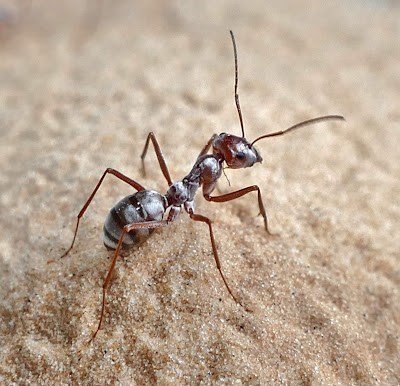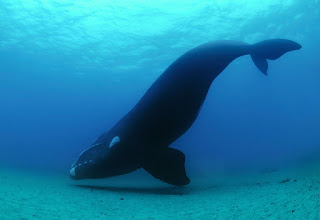Horseshoe Crab (Limulus polyphemus) ~ It is Better to Give than to Receive
The Horseshoe Crab looks like an alien life form rather than
an earth creature. It is more
closely related to spiders and scorpions than actual crabs; this is exemplified
by their whopping 10 eyes that can see UV light. These crabs are categorized in the class “Merostomata” which
means it's legs are attached to it’s mouth (I don’t think they can walk and talk
at the same time…). Without these
creatures, the beloved Red Knot would be extinct. Red Knots feed solely on Horseshoe Crab eggs in their 9,300
mile migration along the coast.
They arrive in the Delaware Bay on the last full moon in May where the
Horseshoe Crab spawns each year.
Here they double their weight before continuing to breeding grounds in
the Canadian arctic.
Horseshoe Crabs are not only useful for the Red Knot,
however. They have also
inadvertently saved countless human lives. Horseshoe Crab blood is used for every single injection,
whether vaccines, drugs, or blood transfusions. Allow me to elaborate in the traditional manner of a
biologist: a diagram!
Clear as mud?
Let me explain.
Gram-negative bacteria is the bad guy in this story. He can withstand steam sterilization, so it's hard to kill. Additionally, this bacteria does not
retain the crystal violet stain which makes positive identification impossible. So if it's there in the blood you are about to transfuse into a sick patient, it will make him only sicker. This endotoxin is the bacterial toxin of greatest concern. Non-pathogenic members love aquatic
environments, making them a constant nightmare for pharmaceuticals. Injections can cause ‘injection fever’,
indicating after-the-fact that the undetectable bacteria endotoxin was
present. This is bad news for the
patient. Yet thanks to the
horseshoe crab, modern medicine has found a way to neutralize the
endotoxin!
The Horseshoe Crab is not only weird on the outside, but
also weird on the inside. For that
weirdness we are continually indebted to them! This organism is quite primal. In fact, it hasn’t really changed since the Paleozoic Era…
before humans, dinosaurs, and flowering plants. As such it has no immune system. Instead, the Horseshoe Crab has amoebocytes constantly
coursing through its blood. These
amoebocytes form clots around endotoxins.
It’s a handy way to get rid of them when you don’t have any white
cells. From these amoebocytes,
scientists created a cell-free reagent (they call it Limulus amoebocyte lysate
or, if you want to text it, ‘LAL’ not to be confused with 'LOL')
Once every year, technicians go out and catch horseshoe
crabs in what they call “The Blood Harvest”. The crabs are drained of 30% of their blood and released
again. This process may sound
brutal, but the mortality rate is only about 3% and blood volume rebounds in
about a week. If you have ever received a vaccine, a drug injection, or a transfusion, thank a horseshoe crab.
What I find so remarkable about this creature is not just
how useful it is, but how quickly it recovers. They get back in the
water and keep swimming year after year, for up to 20 years. It has been hypothesized that those who give more live more, meaning a crab that has given blood tends to be healthier and have a longer lifespan.
A cold hard fact of this life is: people will take things from you. We take what is most precious from each other, sometimes without batting an eye. Proverbs 24v16 says that the righteous may be knocked down seven times, but he rises again. Additionally, it is hard to give to other people. It always costs us something. i remember a woman saying to me once, "It costs nothing to be kind." i disagree. Kindness pulls over on the side of the road to help a stranded person. Kindness stands for 12 hours in the homeless shelter preparing and serving hot meals. Kindness stays up late on the phone with a friend who needs to talk. It costs us our time, our money, our physical energy, our sleep, our efforts. But this is what makes giving so precious! Jesus said, "It is more blessed to give than to receive." How true is this! When we give more, we live more. We grow in trust, we show God's heart to others, and we open the door for God to act in amazing ways. We have been given the power to bounce back, to get back into the water, and that is something worth celebrating.
A cold hard fact of this life is: people will take things from you. We take what is most precious from each other, sometimes without batting an eye. Proverbs 24v16 says that the righteous may be knocked down seven times, but he rises again. Additionally, it is hard to give to other people. It always costs us something. i remember a woman saying to me once, "It costs nothing to be kind." i disagree. Kindness pulls over on the side of the road to help a stranded person. Kindness stands for 12 hours in the homeless shelter preparing and serving hot meals. Kindness stays up late on the phone with a friend who needs to talk. It costs us our time, our money, our physical energy, our sleep, our efforts. But this is what makes giving so precious! Jesus said, "It is more blessed to give than to receive." How true is this! When we give more, we live more. We grow in trust, we show God's heart to others, and we open the door for God to act in amazing ways. We have been given the power to bounce back, to get back into the water, and that is something worth celebrating.
Horseshoe Crab blood
being harvested for LAL. The blood
is blue because they have a copper-based hemolymph to catch and transport
oxygen. You and I have hemoglobin,
which is iron-based, making our blood a red color.





-5.adapt.945.2.jpg)
Comments